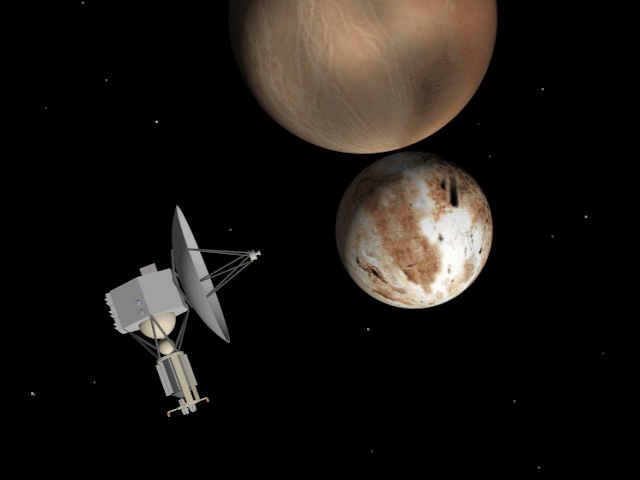
To address these questions, NASA is now developing a robotic reconnaissance mission to Pluto-Charon (artist conception shown below). The Pluto mission is being conceived using lightweight advanced-technology hardware components and advanced software technology. The Pluto mission plan calls for launch when this technology is ready with a goal of encounters with Pluto and Charon around 2010 or later.

If the encounter with Pluto is successful, the mission may be extended to encounter one or more icy, asteroid-sized objects in the Kuiper Disk.
The purpose of the Pluto-Kuiper Express Mission is to conduct first reconnaissance of Pluto and its large moon Charon with low mass flyby spacecraft, using advanced technologies to serve as a pathfinder for low cost exploration of the outer Solar System. This mission will complete the exploration of the last unvisited planet and address fundamental questions about the origin of the solar system. The dark, cold Pluto is an oddity among the planets and may provide considerable information about the early periods of planetary evolution, and perhaps even to the origin of Earth's atmosphere.
Science goals are to: 1.characterize the global geology and geomorphology of Pluto and Charon, imaging both sides of each; 2.map the surface composition; and 3.characterize Pluto's neutral atmosphere, including composition, thermal structure, and aerosol particles.
The second primary objective is to serve as pathfinder for lower cost exploration of the outer solar system, by employing pioneering technologies, operations approaches, development techniques and management styles.
The current mission will be launched to arrive in about 9 years. The flyby velocity will be about 18 kilometers per second. The flyby altitude at Pluto's closest approach will be about 15,000 kilometers, enabling monochromatic mapping of the sunlit halves of Pluto and Charon's geology and geomorphology at 1 km resolution, as well as color mapping at lower resolution. The spatial resolution required for surface composition mapping, using an infrared spectrometer is 5-10 kilometers per pixel. Studies of Pluto's neutral atmosphere will determine the mole fractions of nitrogen, carbon monoxide, methane and other gases to at least the one percent level. Data storage capacity and transmission rates will allow the transmission of 1+ gigabit of science data to the Deep Space Network over a several month period after the encounters. Advanced technologies will be incorporated to meet the stringent cost, mass and power constraints.